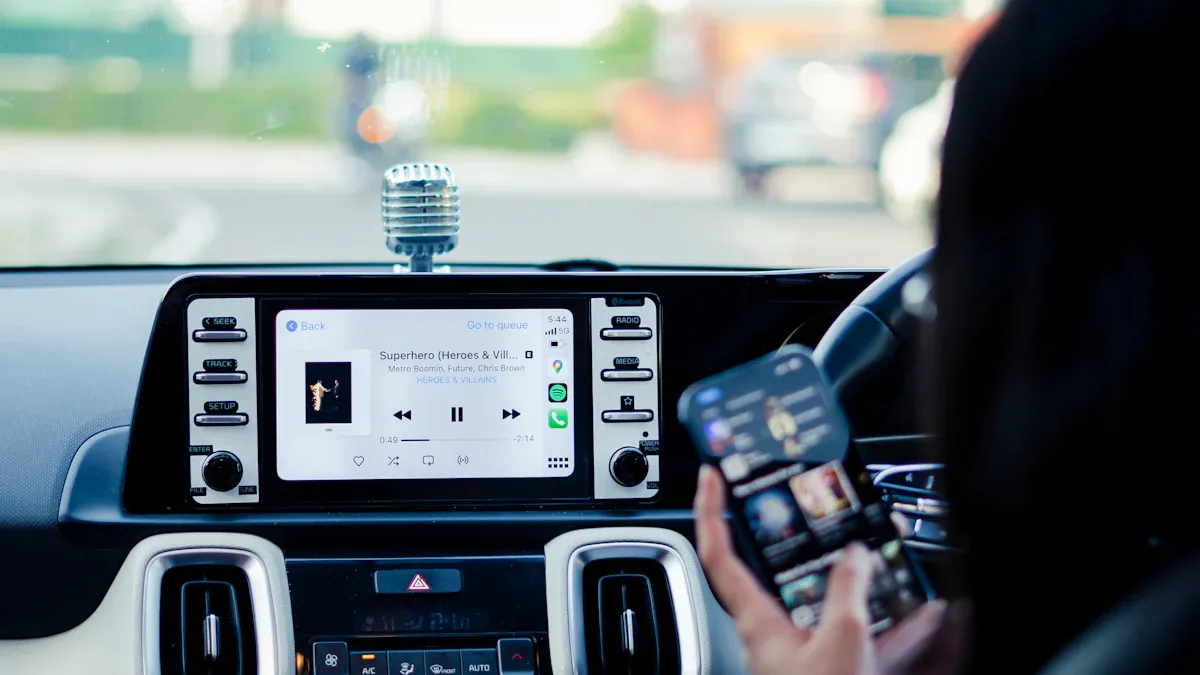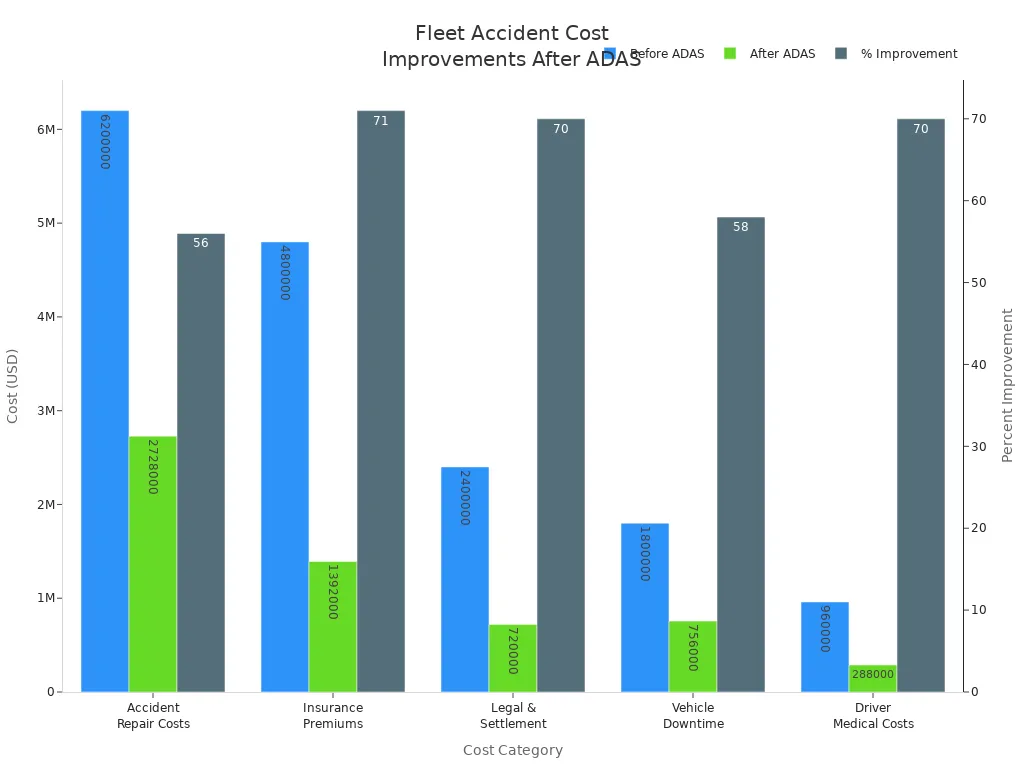
You can stop accidents in dealer fleets by making clear safety rules. Check vehicles often. Make sure drivers follow the rules. Use smart technology to help. Good safety steps save money and help you work better. AI-powered dashcams and GPS let you watch drivers right away. This can lower accident costs. Many companies have fewer claims and give better service when they care about safety.
| Evidence Type | Description |
| Driver Safety | Putting driver safety first lowers accident costs and insurance rates. |
| Technology Integration | AI-powered dashcams and GPS tracking help watch how drivers act. |
| Cost Reduction | Fewer accidents help build a safe workplace and save money. |
Key Takeaways
- Make safety rules easy to understand. These rules help drivers know what to do. They also lower the chance of accidents.
- Check vehicles often. Fix problems early. This keeps fleets safe.
- Use technology like AI dashcams and GPS. These tools watch what drivers do. They help make driving safer.
- Build a safety culture. Talk openly about safety. Praise drivers for safe habits.
- Give drivers training often. Support them as they learn. This helps them drive safely and have fewer accidents.
Dealer Fleets Safety Policies
Having clear safety policies helps keep your fleet safe. It also helps your business run well. Strong rules lower accident risks and protect drivers. Dealer fleets that use good safety steps have fewer claims. They also get better results.
Policy Creation
Start by making a policy that covers all important areas. The best dealer fleets add these things to their safety policies:
- Driver selection and training
- Vehicle maintenance
- Use of technology
- Compliance with regulations
- Accident reporting and investigation
- Driver health and wellness programs
- Safety culture and communication
- Performance monitoring and feedback
To make a strong policy, do these steps:
- Make clear safety rules by watching driver behavior and using tools.
- Check vehicles often to find safety problems.
- Keep track of who uses each vehicle to make people responsible.
- Use fleet hardware to help drivers stay safe.
- Get leaders to support the safety program.
- Teach drivers about safe and defensive driving.
- Plan regular maintenance to stop problems before they happen.
Tip: Use driver scorecards and risk checks to make your work easier and more correct.
Communication
Make sure everyone knows your safety rules. Try these ways to share your rules:
| Method | Description |
| Define and share clear policies | Set rules and expectations so everyone knows what to do. |
| Hold regular safety meetings | Talk about new rules, answer questions, and remind drivers why safety is important. |
| Use technology | Use telematics and apps to watch drivers and check vehicles. |
Remind drivers often that safety matters. Give rewards for good driving to help drivers build safe habits.
Compliance
Check that everyone follows the rules. Dealer fleets use these steps to stay safe:
- Put safety policies in place and look at them often.
- Train drivers when they start and every year after that.
- Use technology to watch how drivers act.
- Inspect vehicles before and after each trip.
- Keep records of all maintenance for at least 14 months.
- Check licenses and do risk checks.
- Report all incidents right away.
Note: Fleet compliance means checking driver hours, vehicle care, driver checks, drug tests, and emissions.
When you make sure people follow the rules, you help keep drivers safe. You also help your fleet work well.
Inspections & Maintenance

Doing regular inspections and maintenance keeps your fleet safe. It also helps your vehicles work well. When you check vehicles often, you lower accident risks. You can also avoid expensive repairs. Telematics and past data help you find problems early. This way, dealer fleets run better and everyone stays safer on the road.
Vehicle Checks
You need to check every vehicle before and after trips. These checks help you find problems early. They keep vehicles in good shape. Checking often also makes roads safer and stops accidents.
| Inspection Type | Purpose |
| Pre-Trip Inspections | Make sure the vehicle is safe before a trip. |
| Post-Trip Inspections | Look for damage or repairs after a trip. |
| Routine Scheduled Inspections | Do regular checks as part of a plan. |
| Ad Hoc Inspections | Check when you think there is a problem or after an incident. |
- Use the same checklist for every inspection.
- Teach your staff what to look for during checks.
- Check inspections often to keep standards high.
Tip: Custom forms for each vehicle model make checks faster and better.
Driver Reviews
Looking at how drivers do their jobs helps stop accidents. You tell drivers what you expect. You make sure they follow the rules. This helps build a strong safety culture. Everyone knows what to do.
| Strategy | Contribution to Accident Prevention |
| Setting Clear Expectations | Stops confusion and helps drivers be safe. |
| Promoting Accountability | Makes drivers answer for their actions. |
| Standardizing Procedures | Keeps training and reports the same for everyone. |
| Leveraging Technology | Lets you watch drivers live and fix unsafe actions fast. |
| Driving a Safety Culture | Shows that safety is important to everyone. |
| Enabling Proactive Risk Management | Uses data to find problems and stop accidents before they happen. |
Maintenance Records
Keeping good records of maintenance is important for safety. These records help you know how each vehicle is doing. You can plan repairs before things get worse.
- Maintenance records show each vehicle’s condition.
- They help you follow safety rules and pass checks.
- You can use records to plan future maintenance.
- Telematics gives you alerts and real-time data for repairs.
- Past data helps you see patterns and fix problems early.
Note: Good records help manage risks and keep dealer fleets safe and working well.
Driver Accountability
Assignment Tracking
It is important to know who drives each vehicle. You also need to see how well they drive. Assignment tracking helps you do this job. New systems let you check which driver uses each car. You can see this at any time. These tools help make sure drivers act responsibly.
- Telematics systems keep track of what drivers do.
- IoT sensors gather information from the vehicles.
- AI-powered analytics help find risky driving.
GPS fleet tracking gives updates right away. You can see where your vehicles are. You can check their speed and if drivers use safe routes. These tools also show if drivers idle too long or turn unsafely. Using assignment tracking helps make your fleet safer.
Tip: Use communication tools to talk with your drivers. GPS and telematics help you check speed, braking, and route choices.
Incentives & Discipline
Giving rewards to safe drivers keeps them focused on safety. Correcting unsafe actions helps everyone improve. You can use different programs to motivate drivers.
| Incentive Type | Description | Results |
| Financial rewards | Bonuses, gift cards, or more pay for good safety records. | Encourages safe driving and makes drivers want to do better. |
| Public recognition | Praise at meetings or events with trophies or certificates. | Makes drivers want to keep driving safely. |
| Additional benefits | Extra days off, better vehicles, or chances to move up. | Gives more reasons for drivers to meet safety goals. |
- The 950 Club gives rewards to drivers with high scores and helps them follow rules.
- Monthly bonuses for top safety scores make everyone try harder to be safe.
- $100 bonuses thank safe drivers and help lower traffic tickets.
When you use rewards and fair discipline, drivers learn and get better.
Safety Training
Regular safety training keeps drivers ready and alert. You teach them about dangers like using phones, being tired, and speeding. Training sets clear rules, like no-phone use and how to handle tiredness. Using event videos and quick coaching helps drivers fix mistakes fast.
- Training helps drivers learn safe habits.
- Regular lessons help lower accident numbers.
- Coaching after risky events means fewer claims.
Dealer fleets that spend time on training have fewer accidents and safer roads.
Fleet Technology

New technology gives you strong tools to keep fleets safe. You can use AI, telematics, and behavior analytics to find risks early. These tools help you watch drivers live and guide them to make better choices.
AI Solutions for Dealer Fleets
AI-powered safety tools are transforming the way fleets manage risk. More companies are now using AI to detect unsafe driving behaviors in real time. Advanced systems can accurately identify issues such as phone distraction, drowsy driving, and tailgating—helping prevent accidents before they happen. As a result, organizations see significant reductions in incidents, operational costs, and compliance risks, while improving overall driver safety and efficiency.
- 40% of leaders want to use AI soon.
- 22% are already adding AI to their fleets.
- 72% spent more on new tech like AI last year.
- Over half of fleets use AI for data, even if not for all choices.
AI gives drivers feedback right away. This helps fix problems fast and keeps everyone safe.
Telematics & GPS
Telematics and GPS let you track vehicles and what drivers do. You get alerts if a driver speeds, brakes hard, or turns sharply. This helps you coach drivers and stop risky habits. Real-time alerts warn drivers about dangers, making roads safer.
| Benefit | Description |
| In-reverse activity collisions | Warns drivers when other vehicles are backing up, so they are more careful. |
| Driver coaching | Gives feedback right away to help drivers be safer. |
| Scorecarding | Tracks things like speeding and seatbelt use to help drivers build safe habits. |
You can see which drivers need more training. Telematics shows you each driver’s habits.
Behavior Analytics
Behavior analytics watches how drivers act on the road. It tracks speed, braking, and turning. You can spot risky habits like speeding, phone use, or hard braking. This data helps you train drivers to be safer.
- The system finds risky actions that raise accident and repair costs.
- AI and telematics work together to watch for safety problems.
- You get almost real-time data to coach drivers quickly.

Advanced technology saves a lot of money. After using ADAS, fleets saw accident repair costs drop by 56%, insurance costs by 71%, and legal costs by 70%. These tools help dealer fleets stay safe and spend less.
Safety Culture
A strong safety culture helps dealer fleets have fewer accidents. When safety is important, drivers know their health matters. This builds trust and makes everyone want to follow safe steps. Teams that care about safety have fewer crashes and do better at work.
Communication
Open talk helps make a safe place to work. Drivers can share worries and ideas with the team. You can do these things to help safety talks:
- Make a handbook with easy-to-read rules.
- Teach new drivers when they join the team.
- Give training all the time, not just once.
- Set rules for how to report problems.
- Use tech to send updates and get feedback.
A safety culture means everyone cares about safety. People keep learning, talk openly, and respect each other.
You should ask for feedback and share good safety news. When you talk about safety a lot, drivers pay more attention and make safer choices.
Recognition
Saying “good job” for safe driving helps your team try harder. You can give prizes or rewards to drivers who follow safety rules. Saying thanks at meetings or giving certificates makes drivers proud. Sharing safety wins shows you care about safe habits.
- Tell drivers what you expect for safety.
- Give rewards for safe driving.
- Celebrate when drivers reach safety goals.
Drivers try more when you notice their hard work. This helps you build a team that cares about safety.
Leadership
Leaders are very important for safety culture. You need to show safe actions and get your team to join safety plans. Good leaders let others help fix problems and make sure everyone is responsible. You can use these leadership ideas:
| Leadership Practice | Description |
| Engaging Leadership | Get your team to join safety programs. |
| Modeling Desired Behaviors | Show the safe actions you want to see. |
| Empowering Team Members | Let drivers help fix safety problems. |
| Creating Accountability | Make everyone feel important and in charge of safety. |
| Communication | Keep talking about safety with your team. |
| Foundational Beliefs | Care about workers and support safety steps. |
You should watch, measure, and help your team do better. Fix unsafe actions fast and change rules if needed. When you act safely, your team will do the same.
If you use a strong safety plan, you get real results. Here are some things that can happen:
| Outcome | Measurement |
| Reduction in Preventable Crashes | 0% fewer road incidents in one year |
| Lower Claim Costs | 0% less money spent because of quick reports |
| Improvement in Driver Retention | 0% more drivers stay with coaching and praise |
Do safety checks every day, week, and year.
- Daily walkarounds help you find problems fast.
- Regular checks keep your fleet safe and following rules.
- A set plan stops surprises from happening.
Better safety steps mean fewer accidents and lower insurance bills. You will also have fewer problems and less time when vehicles can’t be used. Try these tools to keep your drivers and business safe.
FAQ
What is the most important step to prevent fleet accidents?
You should set clear safety rules and make sure everyone follows them. Regular training and inspections help you catch problems early. Using technology like telematics gives you real-time updates.
How does technology help dealer fleets stay safe?
Technology tracks driver actions and vehicle health. You get alerts for risky driving or needed repairs. This helps you fix issues before accidents happen.
Why should you keep maintenance records?
Maintenance records show you when to fix or check vehicles. They help you plan repairs and prove you follow safety rules. Good records lower risks and save money.
How often should you train your drivers?
You should train drivers when they start and give regular updates. Monthly or quarterly sessions work best. Use real-life examples and videos to keep lessons clear.
What rewards work best for safe drivers?
You can give bonuses, gift cards, or public praise. Some fleets offer extra time off or better vehicles. Rewards make drivers want to follow safety rules.
